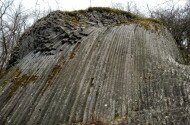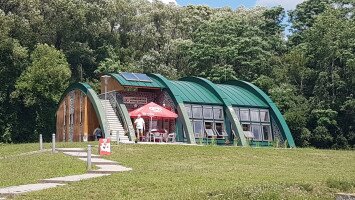
Látogatható geosite.
Története, értéke
Somoskő (vulkáni neck): a legismertebb bazaltfeltárás Bükkrét és Somoskőújfalu között, amelyet már Zipser Ch. A. (1817) és Beudant F. S. (1822) is ismertek. A jelenlegi ismeretek szerint vulkáni neck, amely a lávával kitöltott maar típusú kráterben lávaárba ment át (Gaál 1993, Konečný et al. 2004). A kb. 160 m átmérőjű neck formája asszimetrikus volt, mivel a nyugati oldal csaknem függőleges, amit a vár alatt, a határ közelében lévő oszlopok vízszintes, vagy 20° dőlésű fekvése bizonyít. Ezzel ellentétben az ismert „bazaltorgona“ (Klinda 1976) oszlopai a várhegy keleti lejtőjén 60-80° dőlésűek, ami tükrözi a kráter belső falának enyhe dőlését. A várhegy északkeleti lejtőjén a felvezető tanösvény tufát és kürtőbreccsát is feltár, amelyek a kürtő eredeti kitöltésére utalnak. A bazalt csaknem függőleges érintkezését a környező homokkővel a délkeleti lejtőn található kis homokbánya tárja fel a tanösvény felett. A bazaltorgona enyhén megdőlt, 15-20 cm széles öt- és hatszögű egyedülálló oszlopai jelentős természettudományi értéket képviselnek, amelyek külföldön is jól ismertek. A bazalt radiometrikus kora 4,06 ± 0,06, ill. 4,08 ± 0,03 millió év (Balogh a kol. 1994). A somoskői bazaltból több ásványt is leírtak. Ilyen a chabazit (Zepharovich 1859, Tóth 1882, Hintze 1915), phylipsit (Kalecsinszky 1889), aragonit (Mauritz és Vendl 1942) amfibol (Leonhard 1843), olivin és augit (Mauritz 1910).























